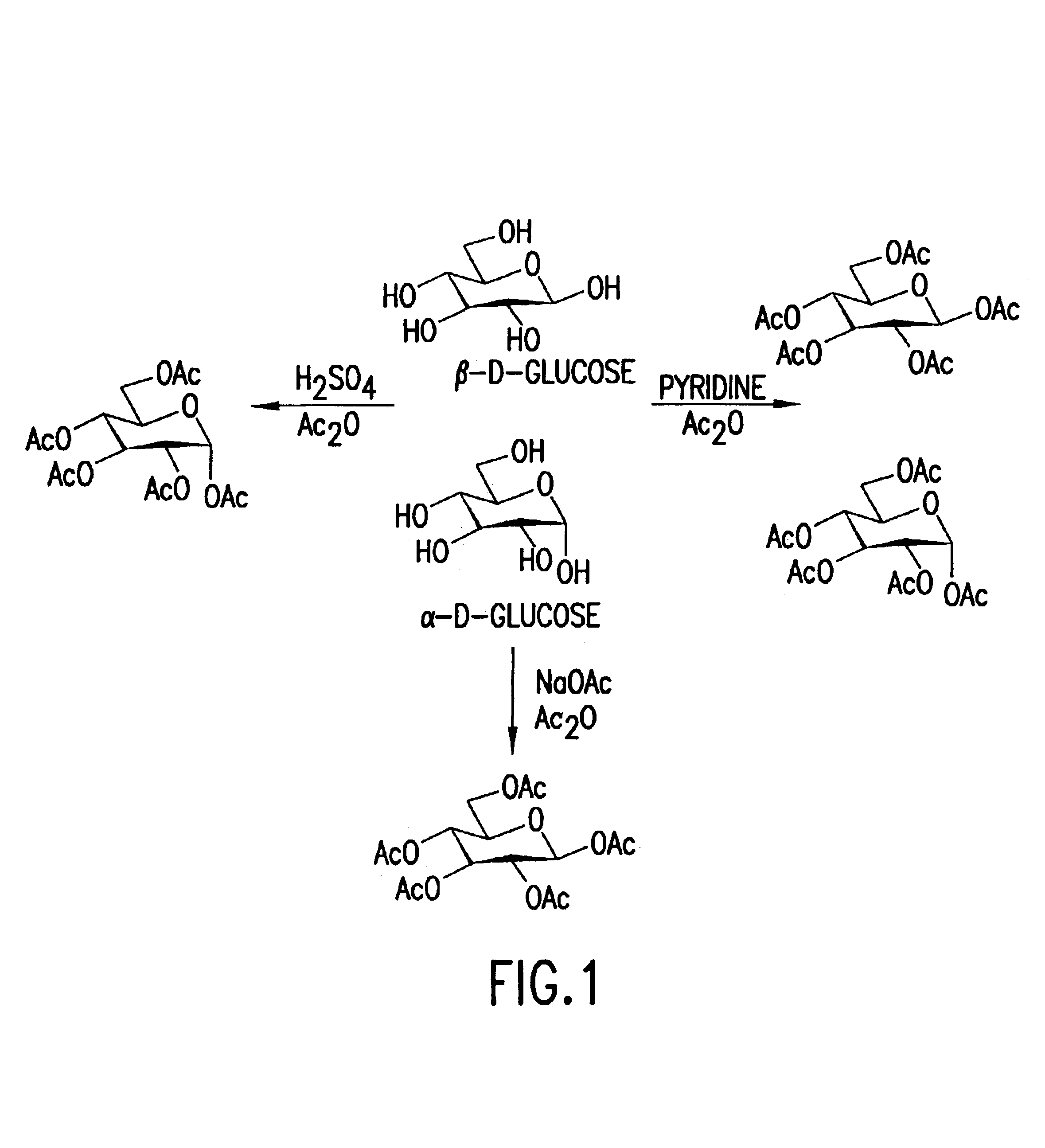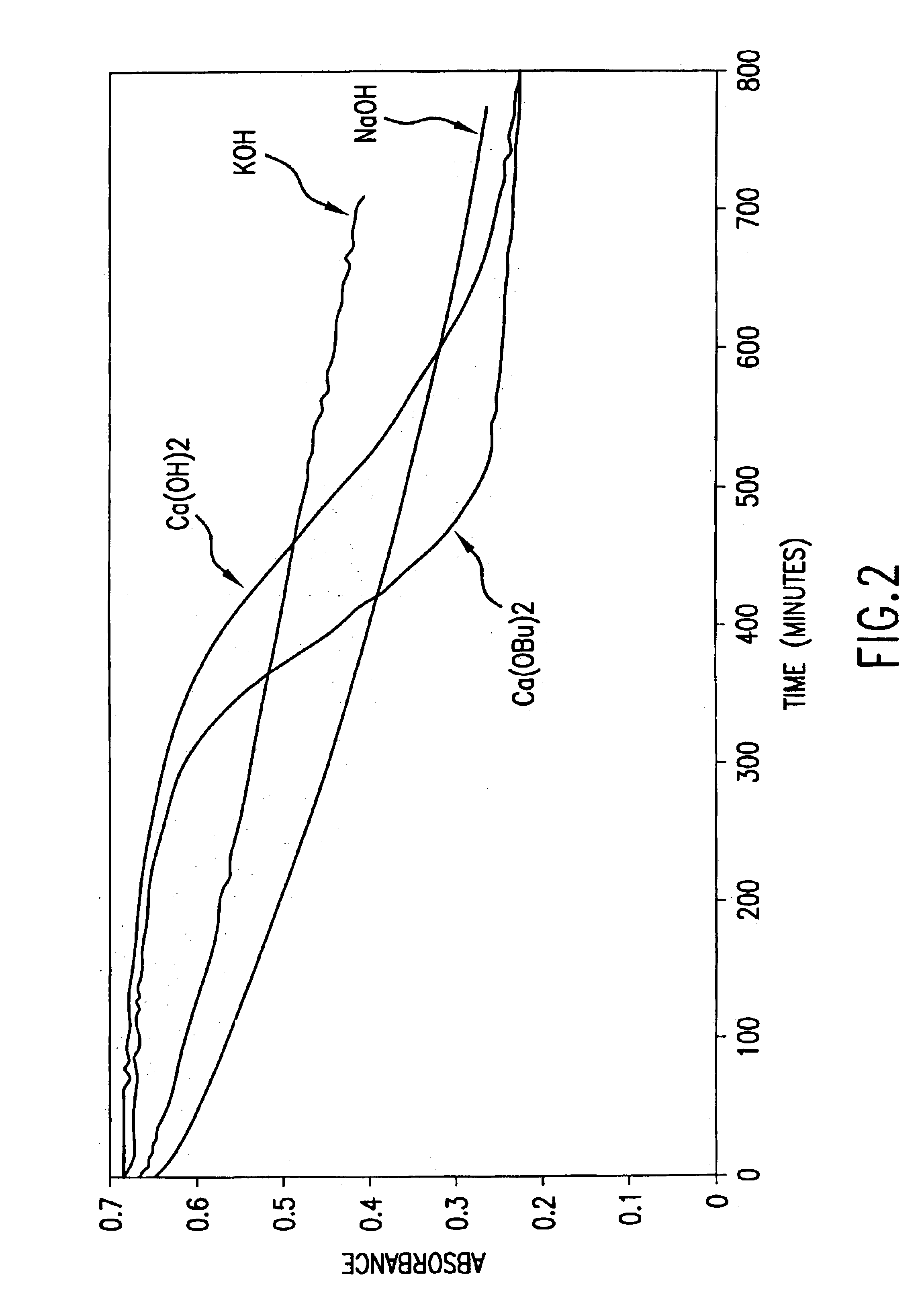Carbohydrate esters and polyol esters as plasticizers for polymers, compositions and articles including such plasticizers and methods of using the same
a technology of carbohydrate esters and polyol esters, which is applied in the direction of dental care, microcapsules, inks, etc., can solve the problems of cellulose esters degrading, minimizing their usefulness in certain applications, and certain difficulties
- Summary
- Abstract
- Description
- Claims
- Application Information
AI Technical Summary
Benefits of technology
Problems solved by technology
Method used
Image
Examples
example 1
Comparison of Different Base Catalysts for the Preparation of Glucose Esters
[0129]In order to evaluate the relative rates of reaction and the impact on the color of different base catalysts in the esterification of carbohydrates, the reactions of α-D-glucose with butyric anhydride catalyzed by NaOH, KOH, or Ca(OH)2 were studied in situ utilizing mid-infrared attenuated total reflectance spectroscopy. The reactions were conducted in a temperature-controlled (±0.1° C.) 1 L automated reaction system configured with a stirrer, water-cooled condenser and nitrogen purge. The reactant / catalyst amounts were adjusted relative to glucose on a molar basis to result in 6 equivalents anhydride (1.2 hydroxyl equivalents) / 1 equivalent glucose / 0.02 equivalents catalyst. Each reaction was conducted at 90° C. while stirring at 150 rpm. Spectra were collected as the average of 100 scans at 8 wave number resolution and at a rate of one per minute. At the end of the prescribed reaction period, each reac...
example 2
Solids Limited Preparation of Glucose Pentapropionate using MSA as a Catalyst
[0131]In a typical procedure, a 12 L 5-neck round bottom flask was equipped with a thermocouple, a reflux condenser, a diamond tipped IR probe for an ASI React IR 4000, a motor driven solids feeder and a mechanical stirrer. Propionic anhydride (6501 g, 50 moles, 1.2 hydroxyl eqs) was added to the flask and the flask was then flushed with N2. The propionic anhydride was heated to the set reaction temperature and 32 g (0.33 moles, 0.04 glucose eqs) of methanesulfonic acid was added. Glucose (1500 g) was fed to the flask at a rate to maintain the desired reaction temperature. If the glucose was fed too rapidly, the reaction exothermed which is noted in Table 1 as the maximum temperature. After all of the glucose had been added (ca. 4 h), the solids feeder was flushed with propionic acid. To reduce the color, 2-3 wt. % of carbon powder was added to the reaction solution. The reaction mixture was concentrated by...
example 3
Anhydride Limited Preparation of Glucose Pentapropionate using Ca(OR)2 as a Catalyst
[0134]In a typical procedure, a 5 L 4-neck round bottom flask was equipped with a thermocouple, a reflux condenser, a diamond tipped IR probe for an ASI React IR 4000, a liquid pump feeder and a mechanical stirrer. Propionic anhydride (722 g, 5.55 moles, 0.4 hydroxyl eqs), propionic acid (750 g), α-D-glucose (500 g, 2.78 moles) and 2.06 g of Ca(OH)2 (27.8 mmol, 0.01 glucose eqs) were added to the flask and the flask was then flushed with N2. The reaction mixture was heated to 90° C. and the consumption of propionic anhydride and production of propionic acid was monitored by IR. When the initial charge of propionic anhydride had reacted, an additional 2.06 g of Ca(OH)2 (27.8 mmol, glucose 0.01 eqs) was added and 1445 g of propionic anhydride (11.1 moles, 0.8 hydroxyl eqs) was pumped to the reaction vessel. The reaction temperature was maintained at 90° C. for 4.9 h before heating to 105° C. where it w...
PUM
| Property | Measurement | Unit |
|---|---|---|
| wt. % | aaaaa | aaaaa |
| wt. % | aaaaa | aaaaa |
| wt. % | aaaaa | aaaaa |
Abstract
Description
Claims
Application Information
 Login to View More
Login to View More - R&D
- Intellectual Property
- Life Sciences
- Materials
- Tech Scout
- Unparalleled Data Quality
- Higher Quality Content
- 60% Fewer Hallucinations
Browse by: Latest US Patents, China's latest patents, Technical Efficacy Thesaurus, Application Domain, Technology Topic, Popular Technical Reports.
© 2025 PatSnap. All rights reserved.Legal|Privacy policy|Modern Slavery Act Transparency Statement|Sitemap|About US| Contact US: help@patsnap.com



